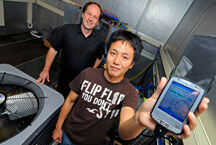Purdue creating center for high-performance buildings at Herrick Labs

Purdue mechanical engineering graduate student Woohyun Kim, at right, and James Braun, a professor of mechanical engineering, use a new technique designed to save energy and servicing costs by indicating when air conditioners are low on refrigerant, preventing the units from working overtime. Technicians servicing home air conditioners might simply plug a personal digital assistant into the unit to read the refrigerant-charge information. The conventional method for accurately learning how much charge is in a system involves removing all of the refrigerant and weighing it, a time-consuming procedure that requires a vacuum pump. (Purdue University photo/Andrew Hancock)
WEST LAFAYETTE, Ind. - Purdue University will create a $23.5 million Center for High Performance Buildings to design systems for future structures that are more environmentally and user friendly, energy efficient, and safe.
Half of the project's cost is funded by the U.S. Commerce Department's National Institute of Standards and Technology, with NIST providing $11.75 million and the other half coming largely from private donors.
NIST announced the Purdue grant as part of more than $123 million in American Recovery and Reinvestment Act funding to support the construction of new scientific research facilities at 11 universities and one non-profit research organization.
With ultimate research targets ranging from offshore wind power and coral reef ecology to quantum physics and nanotechnology, the 12 projects will launch more than $250 million in new laboratory construction projects beginning early this year.
Construction on the Purdue project is expected to begin in February and be completed by December 2012. The center will be housed in a new 68,000-square-foot facility upgrading Purdue's Ray W. Herrick Laboratories.
"The research will attack some of the most daunting and complex problems confronting the world, such as rising energy consumption and environmental pollution, climate change, public health, comfort and security, and issues associated with an aging population," said Leah Jamieson, Purdue's John A. Edwardson Dean of Engineering and Ransburg Distinguished Professor of Electrical and Computer Engineering.
Buildings are responsible for roughly 40 percent of the nation's energy use, 71 percent of electricity consumption and 38 percent of carbon dioxide emissions. Americans typically spend more than 90 percent of their time indoors, while 20 percent to 30 percent of occupants have health problems related to indoor environments, according to a project report prepared by Purdue and NIST.
"Typical buildings may actually be more polluted than the surrounding ambient environment," said Patricia Davies, director of the Herrick Labs and a professor of mechanical engineering. "One of the grand challenges of the center will be to develop an understanding of the relationships between indoor environments and human health and productivity, leading to better systems."
The economic impact related to health and lost productivity caused by poor indoor environments is estimated to be about $200 billion per year in the United States, according to the report. Poor indoor environments can cause respiratory illness, allergies and asthma, sick building syndrome, and musculoskeletal disorders. Buildings located near busy roads, trains and airports are susceptible to air quality issues and noise and vibration that potentially leads to effects such as sleep disturbance, hypertension and heart disease.
The new Herrick building will roughly double the lab's existing space. A special feature of the new facility will be a "living laboratory," a working office wing designed with replaceable modular elements related to communications, electronic controls and equipment; moveable walls, doors and windows; a reconfigurable air distribution and lighting system; and instrumentation to monitor systems and occupants.
Researchers will be able to use the living laboratory to test and validate new building systems and concepts. Similarly, a "perception-based engineering" lab in the new Herrick building will be able to simulate a wide span of building environments. Lighting, acoustic environment, air quality, temperature, humidity, airflow and vibration will be controlled independently.
"For example, replacing conventional thermostats in buildings with mobile human health-and-productivity sensors would determine local environmental conditions tailored to individuals, leading to dramatic improvements in health and productivity," said James Braun, a professor of mechanical engineering involved in buildings research. "Equipment, lighting and appliances in homes and other buildings could adapt for the elderly to compensate for limited hearing and mobility."
The center will include faculty from mechanical engineering and a new architectural engineering program who are already collaborating on research projects and proposals.
Designs also will consider sustainability.
"The carbon dioxide emitted due to generating electricity and refrigerant leaked from air conditioning systems has contributed significantly to climate change," Braun said. "Buildings in the United States account for two-thirds of the country's electricity consumption, and air conditioning was a primary reason for the electricity shortage
At the same time, existing Herrick Laboratories facilities, such as the advanced engines test area, will be replaced and expanded.
The new Herrick facility also will house components of the Federal Aviation Administration multi-university Centers of Excellence for Air Transportation Noise and Emission Reduction and for Airliner Cabin Environment Research.
Private-donor funding includes a $2 million contribution from mechanical engineering alumnus Gerald D. Hines.
The Herrick Labs - administered by the School of Mechanical Engineering - are a hub of industry-oriented research in areas ranging from advanced automotive technologies to "smart" buildings. The labs, which held a 50th anniversary celebration in 2008, are housed in a brick horse barn originally built a century ago near State Street and Russell Drive. The new building is planned to be located adjacent to Herrick, south of
Writer: Emil Venere, (765) 494-4709, venere@purdue.edu
Sources: Patricia Davies, (765) 494-9274, daviesp@purdue.edu
Leah H. Jamieson, (765) 494-5346, lhj@purdue.edu
James Braun, 765-494-9157, jbraun@purdue.edu
Note to Journalists: Video B-roll is available from the Purdue News Service by contacting Jim Schenke, Purdue News Service, at 765-494-6262, jschenke@purdue.edu
Related information:
History and research at the Herrick Laboratories
Related video:
Herrick Labs' 50th anniversary draws engineers, industry leaders from around the world
